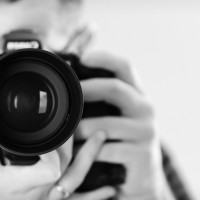Santiago Pascual Buyé is a Spanich photographer. Ever since he was a kid he has been passionate about the world of photography and art in general. He spent many hours in the darkroom developing old negatives. After studying fine art, he focused more on painting and put some of his love of photography aside. It was not until the last few years that he revived that old passion, but this time with a critical sense and maturity. Now it can be said that photography is a passion of which he considers himself to be an eternal apprentice. He is willing to absorb everything that he sees with a critical sensibility and incorporate it into his work gradually.
MOMENTS OF LEVITY AND A SPOON XI
Nikon D2xs . Micro-Nikkor 105mm f/2.8G . 105mm . 1/6400s . f/6.3 . ISO 100
Time is nothing but a collection of moments that we would like to give some order and meaning, to assign a unitary and coherent explanation. However, some of these moments are short-lived, some are barely noticed and some are completely hidden from our view. I wanted to capture these brief moments by pairing some unlikely objects and photographing what should have passed by without our knowing.
Thus was born the series "Moments of Levity and a Spoon," consisting of 11 photographs, of which this is the last image. The purpose of the series is to illustrate ephemeral, fleeting moments that should have elapsed without notice, but have instead been caught and frozen in time through photography. This series is my attempt to allow us to take part in those brief, unseen moments. I want to recreate these unnoticed scenes and anchor them to our visual world. Therefore, two simple items like a spoon and smoke, which a priori could not connect with each other, now come together to form new situations that our naive eyes have never witnessed, like children watching clouds revealing shapes in the sky, masks finally being lifted or unveiling a forgotten past lurking in our visual memory.
"After trying different sources to produce the smoke, I opted to use incense sticks since they generated a very dense smoke with a bluish tint."
So with this concept in mind I started creating the picture using only these two elements. The spoon obviously presented no problems, but the smoke needed to be thick enough to achieve enough prominence in the image that it balanced the spoon. After trying different sources to produce the smoke, I opted to use incense sticks since they generated a very dense smoke with a bluish tint.Once I had decided which items I wanted to use, I started to organize the scene.

Lighting diagram.
"An aperture of f/6.3 assured good sharpness, and it was perfectly adequate for the depth of field required since the smoke and spoon were basically on the same plane."
For the shot I chose a very fast shutter speed (1/6400 second) to fully freeze the scene, and I synced the flashes in high-speed mode using the rear-curtain sync. This speed also allowed the background to remain completely black, providing a good contrast with the subject. An aperture of f/6.3 assured good sharpness, and it was perfectly adequate for the depth of field required since the smoke and spoon were basically on the same plane. I set the camera to its native ISO (100) to avoid introducing noise to the image as much as possible; the Nikon D2Xs does not manage noise very well.With these parameters I shot numerous photographs; as the shape of the smoke is constantly changing and rises very rapidly in a somewhat erratic, uncontrollable manner, the images were all very different. In the end, it's simply a matter of selecting the ones you want to process. In my case, I chose 11 images that I then processed as a complete series.
The RAW file was processed in Aperture, and then the image was exported to Photoshop.
This is the original image.

Original RAW file from camera.
I adjusted a few basic settings in Aperture's Adjustments panel. I increased Exposure to 0.8 and Definition to 0.7. I also set Vibrancy to 0.7 to increase the saturation of the tones in a more controlled way.
I adjusted the Black Point and Recovery settings.
I rotated the image 90° counterclockwise. This was the result.
Finally I exported the image to Photoshop to erase the stream of smoke that filled the spoon, using the Clone Stamp tool. I also used this tool to clean up some undesirable glare caused by the light reflecting off the handle of the spoon. I think the result properly suits the concept of the series and reflects the idea that is implied in the title — that the ephemeral, enigmatic quality of smoke and an everyday spoon contrast without breaking the harmony of the whole.
As you can see, I did not need to make major tweaks in post-processing, and the framing, fortunately, adjusted to the image I envisioned at the outset. From my point of view, having a well-thought-out idea before you start shooting and a good technical approach while you're shooting prevents many unnecessary hours spent in post-processing.










